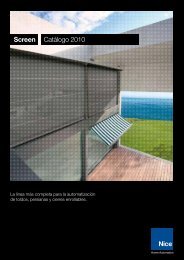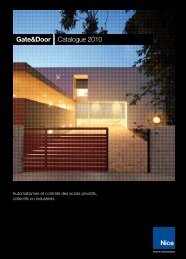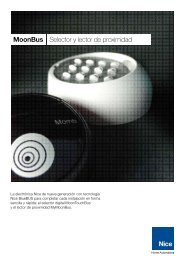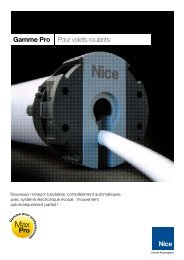Model 7300 INSTALLATION MANUAL APOLLO Gate Operators, Inc ...
Model 7300 INSTALLATION MANUAL APOLLO Gate Operators, Inc ...
Model 7300 INSTALLATION MANUAL APOLLO Gate Operators, Inc ...
Create successful ePaper yourself
Turn your PDF publications into a flip-book with our unique Google optimized e-Paper software.
<strong>APOLLO</strong> <strong>Gate</strong> <strong>Operators</strong>, <strong>Inc</strong>.<br />
<strong>Model</strong> <strong>Model</strong> <strong>7300</strong>ETL-IL<br />
Residential & Heavy Duty Commercial Slide <strong>Gate</strong> Operator<br />
<strong>INSTALLATION</strong> <strong>MANUAL</strong><br />
08/18/09
CONTENTS<br />
IMPORTANT SAFETY INSTRUCTIONS .......................................................... 3<br />
Applications .................................................................................................... 4<br />
Pre-Installation Checklist ................................................................................ 5<br />
Parts Identification .......................................................................................... 6<br />
Pad Installation ................................................................................................ 7<br />
Operator Installation ........................................................................................ 8<br />
Chain Bracket Installation ............................................................................... 9<br />
Chain & Chain Bolt Installation ....................................................................... 10<br />
Chain Magnets Installation .............................................................................. 11<br />
Left or Right Hand Operation …………………………………………………….. 12<br />
Quick Release Operation .................................................................................. 13<br />
Programming Instructions …………………………………………………………. 14<br />
Control Board Connections ............................................................................. 15<br />
Siren Connection ……………………………………………………………………. 22<br />
Radio Receiver Options ……………………………………………………………. 23<br />
Warranty ........................................................................................................... 24<br />
2
IMPORTANT SAFETY INSTRUCTIONS<br />
WARNING - To reduce the risk of injury or death:<br />
<br />
<br />
<br />
<br />
<br />
<br />
READ AND FOLLOW ALL INSTRUCTIONS.<br />
Installation should be performed by a professional installer.<br />
Required welding should be performed by a qualified welder.<br />
Should electricity be required, use a certified electrician only.<br />
Any device that requires 120 Volts AC should be U.L. approved.<br />
Review with the owner all safety concerns including:<br />
Do not operate the gate unless area around gate is in full view.<br />
Never let children operate or play with gate controls. Keep the remote control<br />
away from children.<br />
Always keep people and objects away from the gate. NO ONE SHOULD CROSS<br />
THE PATH OF THE MOVING GATE.<br />
Periodically test the obstruction sensitivity to assure safe and proper<br />
operation. Do not test sensitivity by standing between the gate and the hinge or<br />
stop post.<br />
The “CAUTION AUTOMATIC GATE” signs should be clearly visible from both<br />
sides of the gate.<br />
Always insure that the gate has closed securely before leaving area.<br />
Arrange with local fire and law enforcement for emergency access.<br />
<br />
<br />
<br />
<br />
<br />
<br />
<br />
<br />
Use the emergency release only when the gate is not moving.<br />
A secondary entrapment device such as loop detectors, edge switches, and beam<br />
detectors are highly recommended and required to meet the UL325 standard.<br />
Install control devices such as keypads far enough away (5 feet or further) from any<br />
moving parts of the operator and gate to prevent possible injury.<br />
Do not install control box where the gate can come in contact with person using the<br />
push button on side of control box.<br />
Always disconnect the battery or power source when making adjustments or repairs to<br />
any part of the gate or operator.<br />
All rollers should be covered to prevent injury.<br />
KEEP GATES PROPERLY MAINTAINED. Read the owner’s manual. Have a qualified<br />
service person make repairs to gate hardware.<br />
The entrance is for vehicles only. Pedestrians must use separate entrance.<br />
Test the gate operator monthly. The gate MUST reverse on contact with a rigid object or<br />
stop when an object activates the non contact sensors. After adjusting the force or limit of<br />
travel, retest the gate operator. Failure to adjust and retest the gate operator properly can<br />
increase the risk of injury or death.<br />
SAVE THESE INSTRUCTIONS.<br />
3
APPLICATIONS<br />
The Apollo <strong>Model</strong> <strong>7300</strong>ETL Slide <strong>Gate</strong> Operator is designed to handle a slide gate<br />
up to 32 feet in total length (30 foot gate with 3 foot tail) and 1,000 lbs. A professional<br />
fence or gate dealer is recommended to assure proper installation. Apollo <strong>Gate</strong><br />
<strong>Operators</strong> are available only through qualified dealers with an outstanding reputation<br />
in the fence and gate industry. These dealers will be able to recommend the proper<br />
equipment for particular applications. Apollo <strong>Gate</strong> <strong>Operators</strong> are 12 Volt DC (Direct<br />
Current) powered. A 12 Volt sealed battery (33 ampere hour minimum) is<br />
recommended. There are several advantages with 12 Volt DC systems:<br />
Low voltage virtually eliminates risk of electrical shock.<br />
Battery powered operators provide up to 200 operations in the event of<br />
power outages.<br />
The battery may be recharged with a trickle charger or by solar energy<br />
(Electrical battery chargers should have a class 2 transformer rating).<br />
If a trickle charger is used and a standard electrical outlet is not readily available, a<br />
licensed electrician will be required for proper electrical hook up.<br />
The following table should be used as a guide for capacity of operation of operators<br />
only, additional options may reduce the the daily usage. Please note that the charge<br />
capability of solar panels will vary with different geographical locations. All solar panels<br />
and battery chargers are designed for use with a 12 volt battery.<br />
Daily Cycles 1-10 1-20 1-40 1-60 1-80 80+<br />
5 watt solar panel<br />
10 watt solar panel<br />
20 watt solar panel (requires 5310 regulator)<br />
30 watt solar panel (requires 5310 regulator)<br />
40 watt solar panel (requires 5310 regulator)<br />
1.5 amp battery charger<br />
10 amp battery charger<br />
*<br />
*<br />
*<br />
*<br />
*<br />
*<br />
*<br />
Note: Double the amount of solar panels for Dual <strong>Gate</strong> <strong>Operators</strong>.<br />
4
PRE-<strong>INSTALLATION</strong> CHECKLIST<br />
The following checklist should be used before beginning installation:<br />
• Verify that the proper operator has been selected for this application.<br />
• Verify proper installation and operation of the gate.<br />
1. Are all rollers covered with a protective housing?<br />
2. Are the rollers servicable?<br />
3. Does the gate roll free and level?<br />
4. Will the gate require a locking device?<br />
5. Are the main posts sturdy enough to handle the gate & operator?<br />
• Determine the general location of the operator, chian brackets, and solar<br />
panel (if used).<br />
1. Is there a suitable location for the operator?<br />
2.Can the solar panel (if used) be mounted in an unobstructed area facing<br />
south?<br />
3. Will additional solar panel cable be required?<br />
4. Is electricity available (if required)?<br />
• Consider safety and access options. Recommend if needed.<br />
1. Will there be chidren or animals in the area?<br />
2. Are safety loops, edge switches, or photo beam detectors required?<br />
3. How can the gate be opened in emergencies?<br />
4. How will visitors enter and exit?<br />
5. Will vehicles (and trailers) have sufficient room off roadway to operate any<br />
control devices such as keypads?<br />
5
PARTS IDENTIFICATION<br />
Chain Brackets (2)<br />
Operator<br />
5/16 Washers, Lock<br />
Nuts, & Nuts (8 each)<br />
Chain Bolts with hardware (2 each)<br />
5/16 U Bolts (4 each)<br />
Master Chain Links (2 each)<br />
Tie Wraps (4 each)<br />
#40 Roller Chain (35 feet)<br />
#201<br />
5 Watt Solar Panel & Bracket<br />
(optional)<br />
#404C<br />
Automatic Battery Charger (optional)<br />
6<br />
#273G<br />
CAUTION Signs (2 each)
PAD <strong>INSTALLATION</strong><br />
Direction of Opening<br />
5”<br />
12” 24”<br />
24”<br />
Driveway<br />
Pad Pad Location<br />
Fig. A<br />
Fig. B<br />
Conduit requirements should be considered in the planning stage. If electrical power is required, a<br />
separate conduit should be installed for electrical only. A certified electrician should be consulted for<br />
the proper conduit material (Figure C & D).<br />
14”<br />
3”<br />
5”<br />
AREA FOR CONDUIT<br />
ENTRY<br />
Fig. C<br />
Fig. D<br />
7
OPERATOR <strong>INSTALLATION</strong><br />
Four 1/2” anchor bolts (not supplied) are<br />
recommended to mount the chassis. The<br />
holes should be drilled with a 1/2”<br />
concrete drill bit.<br />
STEP 1. Set the operator on the pad as shown. Align the sprockets 3 to 5 inches from the inside<br />
surface of the gate.<br />
STEP 2. Mark the four mounting holes on the pad.<br />
STEP 3. Remove the operator and drill the holes according to the anchor bolt manufacturers instructions.<br />
STEP 4. Replace the operator and fasten to the pad.<br />
3”-5”<br />
Chain path<br />
(Make sure<br />
the chain<br />
path clears<br />
all posts and<br />
obstacles).<br />
Mounting Holes<br />
(4)<br />
TOP VIEW<br />
8
CHAIN BRACKET <strong>INSTALLATION</strong><br />
STEP 1. Assemble chain bracket with 5/16” U-bolt & hardware to each end of the gate as shown.<br />
Do not tighten at this time.<br />
STEP 2. Align the left chain<br />
bracket slot with the top teeth<br />
of the idler sprocket.<br />
TIP: If welding equipment is<br />
available, tack weld the chain<br />
bracket to the gate on each<br />
end to prevent slippage.<br />
Idler Sprocket<br />
Main Sprocket<br />
STEP 3. Align the right<br />
chain bracket slot with the<br />
bottom teeth of the main<br />
sprocket.<br />
STEP 4. Tighten all hardware.<br />
9
CHAIN & CHAIN BOLT <strong>INSTALLATION</strong><br />
STEP 1. Position the gate so that the operator is in the center of the<br />
gate. Connect chain bolt to the chain bracket as shown on both ends of<br />
the gate.<br />
STEP 2. Attach the chain to the chain bolt using the master chain link. Do not<br />
tighten the chain bolts .<br />
Note: A chain breaking tool may<br />
be required to reduce the chain to<br />
the proper length.<br />
10
Internal Limit Adjustment<br />
Step 1. Press LED Enable once on the<br />
right side of the circuit board. The STOP<br />
LED should illuminate. This is a standard<br />
condition.<br />
Step 2. Turn switch #1 OFF on the control board<br />
Step 3. Activate the gate until the CLOSED LIMIT<br />
LED is illuminated<br />
Step 4. Adjust the corresponding limit switch for preferred<br />
close position.<br />
Step 5. Repeat steps 3 & 4 for setting the open limit<br />
Limit adjustment for left<br />
movement<br />
(gate moving to the left)<br />
- less travel<br />
- more travel<br />
Limit adjustment for right.<br />
Movement<br />
(gate moving to the right)<br />
- less travel<br />
- more travel<br />
TIP: If the limits require extensive adjustment use a 13/32” or 25/64” socket with a portable drill<br />
for course adjustment, then adjust manually for fine adjustment.<br />
11
Left or Right Hand Operation<br />
Wiring Instructions<br />
STEP 1. Determine which direction the gate will open. The factory units are plugged into INPUT B<br />
for right hand opening as shown in Fig. 1.<br />
For left hand opening, disconnect from INPUT B and plug into INPUT A on the surge<br />
board as shown in Fig. 2.<br />
Right Side Installation<br />
Left Side Installation<br />
Red<br />
Black<br />
Green<br />
Orange<br />
White<br />
Red<br />
Black<br />
Green<br />
Orange<br />
White<br />
Fig. 1<br />
Right Hand Opening<br />
Fig. 2<br />
Left Hand Opening<br />
<strong>Gate</strong> in closed position<br />
<strong>Gate</strong> in closed position<br />
operator<br />
operator<br />
12
QUICK RELEASE OPERATION<br />
Engaged<br />
Engaged<br />
Pull & turn 1/2 inch to disengage<br />
13
STEP 7<br />
Programming Current Sensing<br />
The 835/836 control boards incorporate a safety feature that will put the operator<br />
into a hard shutdown mode if the control board detects a current sense<br />
two consecutive times during a cycle. This hard shutdown condition can only<br />
be reset by shorting the FIREBOX or UL connectors on the left side of the<br />
control board to ground. This condition may also be reset by pressing the<br />
HARD SHUTDOWN RESET button located toward the upper right hand corner<br />
of the control board. If a firebox is used in the installation, The firebox<br />
door (optional) should be opened and closed to reset the control board.<br />
The following instructions must be followed at installation for proper safety assurance.<br />
All limits should be set before beginning this procedure.<br />
This new procedure applies to revision 31 or higher firmware.<br />
1. Press and hold the LED ENABLE button for five seconds. The STOP LED will blink<br />
indicating that the board is in learn mode.<br />
3. Cycle gate for 3 full cycles. The STOP LED will stop blinking indicating that the board<br />
is now ready for normal operation<br />
4. Test the auto reverse sensitivity to ensure maximum safety protection. The current<br />
sensitivity adjustment pot may be adjusted to decrease or increase sensitivity.<br />
COUNTER CLOCKWISE<br />
More sensitivity<br />
<strong>Gate</strong> is easy to current<br />
sense<br />
CLOCKWISE<br />
Less sensitivity<br />
<strong>Gate</strong> is harder to<br />
current sense<br />
8. Refer to the 835/836 Operator Control Board Manual to set other options such as<br />
program switch options and close timer adjustments.<br />
Installation is now complete.<br />
Note: Program switch #9 is no longer functional and the current sense may be readjusted<br />
at any time.<br />
14
<strong>APOLLO</strong> <strong>Gate</strong> <strong>Operators</strong>, <strong>Inc</strong>.<br />
835/836 <strong>Gate</strong> Control Board<br />
Firmware Version 31 and up<br />
Rev F<br />
07/15/2005<br />
15
PROGRAMMING INSTRUCTIONS<br />
Once the operator is installed or if the control board is replaced, you will need to program<br />
the control board for proper current sensing. The operator should be functional and the<br />
open and close limits set.<br />
1. Push and hold the LED ENABLE button for five seconds.<br />
The “STOP” LED will blink indicating the board is in learn mode.<br />
2. Cycle the gate three full times (must read open and close limit switches each cycle).<br />
The “STOP” LED will now stay illuminated.<br />
3. Adjust the current sensitivity pot to insure safe operation<br />
The current sensitivity may be readjusted at any time without relearning the board.<br />
Periodically check the current sensitivity for safe operation.<br />
16
835/836 Control Board Parts Identification<br />
Program Switches<br />
Timer To Close -<br />
Dual <strong>Gate</strong> Delay -<br />
Current Sensitivity -<br />
Adjustments<br />
Microprocessor<br />
<strong>Gate</strong>Link Connector<br />
Hard Shutdown Reset<br />
Operate Push Button<br />
Remote Monitor Outputs<br />
and Photo Eye<br />
Optional Device Inputs<br />
LED Enable & Learn<br />
Mode Push Button<br />
Stop Circuit Jumper<br />
Control Board Reset<br />
Fire & ETL Inputs<br />
Optional Device Input<br />
Emergency Bypass<br />
Actuator Connector<br />
(Slave)<br />
Reverse Battery Polarity<br />
Indicators<br />
Actuator Connector<br />
(Master)<br />
17
7<br />
5<br />
3<br />
1<br />
8<br />
6<br />
4<br />
2<br />
Actuator Connector<br />
Board Actuator Function<br />
Cable<br />
Pin 1 Orange Open Limit<br />
Pin 2 White Close Limit<br />
Pin 3 Black Motor (positive on open, negative on close)<br />
Pin 4 Red Motor (negative on open, positive on close)<br />
Pin 5 Green Common for both limit switches<br />
Pin 6 Yellow Feedback from intelligent actuator(816E/816EX)<br />
Pin 7 Black Battery Negative<br />
Pin 8 Red Battery Positive<br />
EMERGENCY BYPASS (open only)<br />
Applies battery voltage directly to motor to open gate if<br />
control board fails. User must unplug before gate opens<br />
to maximum travel or 15 amp fuse will open. Fuse<br />
should be checked before returning gate to service.<br />
Remote Outputs and Photo Eye Hookup<br />
12V<br />
MAS<br />
SLV<br />
GND<br />
Supplied battery voltage<br />
Master Operator Indicator (indicates master side of gate is closed)<br />
+12V when on closed limit. Ground when off of closed limit.<br />
Slave Operator Indicator (indicates slave side of gate is closed)<br />
+12V when on closed limit. Ground when off of closed limit.<br />
Battery supplied ground<br />
SIREN Connect to siren +<br />
applies +12V when gate(s) are running, or in hard shutdown<br />
GND<br />
LOCK<br />
Battery supplied ground<br />
Connect to lock + (optional) Magnetic or Solenoid type locks (Dip Switch #6 Selectable)<br />
Photo Eye Hookup<br />
Photo eye / safety loop wiring. Connect the positive power wire of the accessory to<br />
12V. Connect the ground wire of the accessory to MAS (upper right area of the<br />
835/836 board). Connect the relay wires of the accessory as normal: COM to GND.<br />
NO to SAFETY (#14) (for a safety device). When the gate operator begins opening<br />
(comes off of the closed limits) the MAS terminal will become a ground and will<br />
complete the flow of power to the accessory. This will power the accessory up and it<br />
will work as normal until the gate gets closed and the MAS terminal switches and the<br />
device will power down.<br />
18
Adjustments<br />
TIMER TO CLOSE<br />
Adjusts time before gate automatically closes<br />
Adjustable 5 to 70 seconds.<br />
DUAL GATE DELAY<br />
Adjusts delay between master and slave operation<br />
0-4 seconds (836 only for use with<br />
magnetic, solenoid, and other locking de<br />
vices)<br />
CURRENT SENSITIVITY <strong>Inc</strong>reases or decreases the Auto Reverse<br />
sensitivity.<br />
Push Buttons<br />
OPERATE<br />
When depressed, activates the gate. Used for initial<br />
installation and testing.<br />
Hard Shutdown Reset Resets the operator when the gate current<br />
senses twice before fully opening or closing.<br />
LED ENABLE When depressed, activates LEDs for 15<br />
minutes to assist in installation and troubleshooting.<br />
Hold the push button down for five seconds to put<br />
the board in program mode.<br />
RESET<br />
Resets the microprocessor. Returns processor to<br />
last known state.<br />
Jumpers<br />
STOP CIRCUIT JUMPER When the STOP CIRCUIT<br />
program switch #5 must be ON JUMPER is connected, the gate<br />
will operate normally.<br />
STOP CIRCUIT JUMPER When a 3-button station is conprogram<br />
switch #5 must be OFF nected to the board, the STOP<br />
CIRCUIT JUMPER must be removed.<br />
19
Program Switches<br />
OFF<br />
ON<br />
1 TIMER TO CLOSE <strong>Gate</strong> does not automatically close. <strong>Gate</strong> automatically closes.<br />
2 TIMER TO CLOSE OPT. <strong>Gate</strong> automatically closes from <strong>Gate</strong> automatically closes only when completely<br />
any position after opening.<br />
open (open limit engaged).<br />
3 SLAVE DISABLE Enables slave side (dual gate use). Disables slave side. (single gate use)<br />
4 SIREN DELAY Siren (optional) active when gate is Siren (optional) starts 5 seconds before gate moves.<br />
moving.<br />
5 ‘STOP’ CIRCUIT ENABLE Must hold down open or close Normal operation<br />
buttons to move gate. <strong>Gate</strong> stops Momentary open or close input runs gate to limit.<br />
when button released.<br />
6 LOCK TYPE For 12V mechanical (solenoid) locks. For 12V magnetic locks.<br />
(+12V for 4 seconds on open cycle) (+12V when on close limit)<br />
7 COAST ENABLE <strong>Gate</strong> will stop immediately when at <strong>Gate</strong> will coast (minimally) when it reaches limits.<br />
Open or Close limit<br />
Recommended for 7500 slide operator only.<br />
8 FREE EXIT OPT. A free exit input will open gate from A free exit input will open gate from any<br />
closed position or after a close cycle position after an open or close cycle.<br />
only.<br />
9 DUAL GATE SYNC Both gates operate at normal This feature will control the master gate to open<br />
Speed (slave slower than<br />
or close at the same speed as the slave gate.<br />
Master).<br />
10 SMART ACT. Off for 416E & 416EX actuators, Used for 816E & 816EX actuators only<br />
slide gates, 3500 or when slow down (soft start & stop).<br />
feature is not desired.<br />
20
Optional Device Inputs<br />
GND<br />
INP<br />
12V<br />
GND<br />
INP<br />
12V<br />
EDGE<br />
EDGE<br />
GND<br />
GND<br />
STOP<br />
Supplied Battery Ground<br />
Activate <strong>Gate</strong> (Push button activation when momentarily shorted to ground)<br />
Supplied Battery Voltage (Protected with 3 Amp fuse)<br />
Supplied Battery Ground<br />
Activate <strong>Gate</strong> (Push button activation when momentarily shorted to ground)<br />
Supplied Battery Voltage (Protected with 3 Amp fuse)<br />
Reverse edge input. When grounded, will stop and reverse gate if closing, resets close timer if gate is open.<br />
Reverse edge input. When grounded, will stop and reverse gate if closing, resets close timer if gate is open.<br />
Supplied Battery Ground<br />
Supplied Battery Ground<br />
Stop input from a 3 button station (must remove STOP CIRCUIT JUMPER) Normally closed<br />
CLOSE Close input from a 3 button station (see program switch #5 for options)<br />
OPEN<br />
GND<br />
GND<br />
Open input from a 3 button station (see program switch #5 for options)<br />
Supplied Battery Ground<br />
Supplied Battery Ground<br />
FREE EXIT<br />
Opens gate if closed, stops and reverses gate if closing, resets close timer if gate is open.<br />
GND<br />
Supplied Battery Ground<br />
SHADOW<br />
Resets close timer when gate is open (also referred to as under gate loop)<br />
GND<br />
SAFETY<br />
GND<br />
Supplied Battery Ground<br />
Resets close timer if gate is open, stops and reverses if gate is closing. (Does not open a closed gate)<br />
Supplied Battery Ground<br />
FIRE<br />
UL<br />
When grounded, opens gate and holds gate open until released.<br />
Clears “Hard Shutdown” mode of software.<br />
When grounded, opens gate and holds gate open until released.<br />
Clears “Hard Shutdown” mode of software.<br />
GND<br />
INP<br />
12V<br />
Supplied Battery Ground<br />
Activate <strong>Gate</strong> (Push button activation when momentarily shorted to ground)<br />
Supplied Battery Voltage (Protected with 3 Amp fuse)<br />
21
<strong>APOLLO</strong> <strong>Gate</strong> <strong>Operators</strong>, <strong>Inc</strong>.<br />
911 Siren<br />
The 911 Siren is included with all Apollo ETL <strong>Gate</strong> <strong>Operators</strong>.<br />
Mount siren in an area that will produce maximum performance (additional wire may be required).<br />
Connect the red wire to the SIREN connector on the Remote Monitor Output Connector block.<br />
Connect the black wire to the GND connector on the Remote Monitor Output Connector block.<br />
Red<br />
Black<br />
Set Program Switch # 4 as preferred:<br />
ON - Upon activation, Siren will start for 5 seconds before gate(s) begin moving.<br />
OFF - Siren and gate(s) start immediately upon activation.<br />
22
<strong>APOLLO</strong> <strong>Gate</strong> <strong>Operators</strong><br />
RECEIVER OPTIONS<br />
Do not confuse the receiver code switches with the red program switches on the gate control board.<br />
Never set all code switches to the same position. Transmitters must match code switches for proper operation.<br />
If power is taken directly from battery or connected as shown below, receiver should be configured for 12VDC<br />
Multi-Code/Digi-Code<br />
black<br />
gray<br />
gray<br />
red<br />
Allstar<br />
white<br />
black<br />
red<br />
Lift-Master*<br />
1<br />
2<br />
3<br />
4<br />
Heddolf<br />
black<br />
white<br />
yellow<br />
red<br />
Linear<br />
white/silver<br />
common<br />
n/o<br />
white/gold<br />
* Lift-Master will require that the 12/24 jumper be set to 12 and the C/M (constant/momentary) jumper be set to C<br />
23
TROUBLESHOOTING<br />
The Apollo 835/836 board is the standard board in all ETL compliant Apollo <strong>Gate</strong> <strong>Operators</strong>.<br />
Single gate systems use the 835 board (distinguished by MASTER and EMER-<br />
GENCY BYPASS modular receptacles) and DUAL gate systems use the 836 board<br />
(distinguished by MASTER, SLAVE and EMERGENCY BYPASS receptacles). The 836<br />
board may be used in single gate applications by simply turning PROGRAM SWITCH #3<br />
to the OFF position and only using the MASTER receptacle of the board. Apollo 7000<br />
ETL and 7100 ETL systems use a Stature Electric direct current motor while the Commercial<br />
7200 ETL and <strong>7300</strong> ETL use a Bison direct current motor. Both motors are similar<br />
in design and thus trouble shooting for all of the slide gate systems is covered in one<br />
manual. Keep in mind that SLIDE GATE operators do NOT utilize the “SMART ACTUA-<br />
TOR” feature of the 835/836 board so Program switch #10 must ALWAYS be in the OFF<br />
position. Trouble Shooting the Apollo 7000/7100/7200/<strong>7300</strong> ETL systems:<br />
1. Check your battery! The battery in your gate operator is the power source for the<br />
entire system. If it is not adequately charged, the system will not operator properly.<br />
Test the battery by checking the voltage with a volt-meter while the battery is under<br />
load (gate operating). For AC charged systems – unplug the battery charger<br />
before load testing battery. Battery voltage should be 11.5 volt DC or higher while<br />
the operator is running (battery under load).<br />
2. Program Switch Settings: At the upper center of the board there are 10 program<br />
switches. These switches enable and disable certain features of the Apollo system.<br />
DEFAULT setting of these switches is as follows: SINGLE GATE – 1,2,3,5<br />
ON (all others OFF) DUAL GATE – 1,2,5 ON (all others OFF)<br />
3. LED ENABLE BUTTON: On the right side of the board – half way down is the LED<br />
ENABLE button. Pressing this button once and releasing it “enables” the LEDs on<br />
the board for approximately 15 minutes. When the LEDs are enabled – the “STOP”<br />
light should always be lit on the left side of the board. Other LEDs may be lit as<br />
well depending on the status of the operator. If the gate(s) are in the OPEN position,<br />
the OPEN limit indicator(s) should be lit. If the gate(s) are CLOSED, the<br />
CLOSED limit indicator(s) should be lit. (The OPEN and CLOSED LEDs should<br />
never be on at the same time) Any LEDs that are lit on the left side of the board or<br />
at the lower right corner of the board (except the STOP LED) indicate a TRIGGER<br />
from an accessory device connected at that location. Devices connected where an<br />
LED is lit should be removed before further testing is done. After the system is<br />
made operational – these devices may be reconnected one at a time. Check for<br />
proper system operation after each connection.<br />
4. Current Sensitivity: At the top center of the board is the “Current Sensitivity” adjustment.<br />
It adjusts the amount of force the operator will exert before it senses an obstruction.<br />
As the wheel is turned counter clockwise, the operator will reverse more<br />
easily. As the wheel is turned clockwise, the operator will push harder. Any time<br />
the system “CURRENT SENSES” it will stop and reverse for two (2) seconds. If<br />
the system “CURRENT SENSES” a second time before fully opening or closing –<br />
it will again reverse for two (2)_seconds and then go into a HARD SHUTDOWN<br />
(see below). Sensitivity should be set to a level that is sufficiently strong to open<br />
and close the gate in all conditions – yet still sensitive enough to be safe. A good<br />
starting point is the one o’clock position.<br />
24
TROUBLESHOOTING<br />
5. Activating the system: A momentary connection between activation inputs and ground<br />
(GND) is how the system is activated. At the upper left and bottom right of the board<br />
are terminals marked INP or INPUT. These terminals - when momentarily shorted to<br />
ground (GND) - will open, stop and close the gate with each activation. The button on<br />
the side of the box (swing gates ONLY) is connected to these terminals and may be<br />
used to activate the gate when the key is in the horizontal position. On our newest<br />
boards there is an “OPERATE” button at the upper left area of the board that may be<br />
used in the same manner.<br />
6. HARD SHUTDOWN: If the system has encountered an obstruction two times before<br />
fully opening or closing – the HARD SHUTDOWN LED (upper right of board) will begin<br />
flashing – indicating a Hard Shutdown situation. Check to see that any obstructions<br />
are removed from the gates path and then press the “HARD SHUTDOWN RE-<br />
SET” button to restart the system.<br />
7. Left Hand / Right Hand Operation: All <strong>APOLLO</strong> Slide <strong>Gate</strong>s are shipped from the factory<br />
wired to close to the left (when looking out of the property). It is suggested to install<br />
and adjust the operator as it comes from the factory – then re-wire the system if<br />
necessary. The easiest way to determine if your system requires re-wiring is to use<br />
the LED Enable button. Once the LEDs are enabled, the OPEN LIMIT light should<br />
come on in the open position and the CLOSED LIMIT light should come on when the<br />
gate is closed. Should these be backwards – make the following changes: From the<br />
MASTER plug – there are five wires going to a terminal strip… Reverse the RED with<br />
the BLACK - and – reverse the ORANGE with the WHITE. To verify that the wiring<br />
has been changed correctly: Manually move the gate to the mid-way position and plug<br />
the main harness into the EMERGENCY BYPASS receptacle – the gate should<br />
OPEN. If it closes – the RED and BLACK motor wires must be reversed. Once it is<br />
verified that the EMERGENCY BYPASS does open the gate – then check the limit<br />
switch wiring. Dis-engage the mechanical release and open the gate fully – verify the<br />
OPEN LIMIT led is on. Close the gate fully – verify the CLOSED LIMIT led. If the limits<br />
are backwards – reverse the ORANGE and WHITE limit wires.<br />
8. Dual <strong>Gate</strong> Systems: Test dual gate systems individually. Turn program switch #3 ON<br />
(disables SLAVE side of board) and test actuators one at a time using MASTER side<br />
of board only. Confirm proper operation of each actuator. If both test 100% - then test<br />
together by connecting both actuators and turning program switch #3 to the OFF position.<br />
9. EMERGENCY BYPASS: At the bottom left of the board is the EMERGENCY BYPASS<br />
receptacle. Plugging the operator harness into this receptacle will OPEN the gate<br />
ONLY! It is intended to open the gate(s) should other methods fail. Note that if the motor<br />
draws more than 15 amps of current the fuse above the receptacle will blow. Also,<br />
the gate operator will not stop by its self at the open position. The plug must be removed<br />
to stop the gate. (This is also a handy way to test that the current consumption<br />
of the motor is within the normal limits)<br />
10. FIRMWARE: In the upper right area of the board there is a micro-processor that has a<br />
white label on it. This is the “FIRMWARE” of the system. Currently (May 2005) we are<br />
using firmware version V31.00.02. For troubleshooting versions of the firmware earlier<br />
then V31.00.00 consult your original instructions that were included with your system.<br />
Systems that are out of warranty may be upgraded to newer version firmware for a<br />
nominal fee.<br />
25
<strong>APOLLO</strong> <strong>Gate</strong> <strong>Operators</strong>, <strong>Inc</strong>.<br />
LIMITED TWO-YEAR WARRANTY<br />
Apollo <strong>Gate</strong> <strong>Operators</strong> are warranted against defects for a period of<br />
24 months from the date of purchase, providing recommended installation<br />
procedures are followed. This warranty is in lieu of all other warranties<br />
expressed or implied (some states do not allow limitations on how long an<br />
implied warranty lasts, so this limitation may not apply to you) and shall be<br />
considered void if damage was due to improper installation or use,<br />
connection to improper power source, or if damage was caused by fire,<br />
flood, or lightning. The manufacturer will not be responsible for any labor<br />
charges incurred in the removal or replacement of defective parts.<br />
In case of failure due to defective material or workmanship during the<br />
warranty period, the defective part will be repaired or replaced at the<br />
manufacturer’s option at no charge if returned freight prepaid. New or factory<br />
rebuilt replacements may be used. Replacement parts are warranted for the<br />
remaining portion of the original warranty period. The manufacturer will pay<br />
standard ground freight on the return of repaired or replaced items in<br />
warranty.<br />
26

















